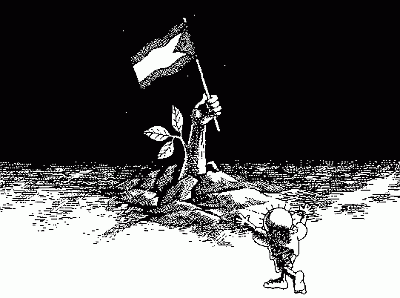Well, a fellow blogger (who I think that blog is a wonderful blog) left me a comment which got me thinking about the Cedars of Lebanon and foreign offensive towards the country.
For those who are unaware of the Cedar tree, a cedar tree is what you see on the Lebanese Flag, and this tree used to cover most of Lebanon. Actually, the name of the Cedar tree, al-Arzi, in Arabic, has been symbolizing Lebanon, and plenty of parties. The Lebanese Forces and Phalanges have the Cedar in their flag, the party of Liberation (al-Ahhrar) also have the Cedar in their flag (not to forget it was the Christian Maronite forces that advocated the creation of Lebanon and split it away from Syria (not that French Imperialism wasn't thinking of an excuse to impose its mandate over the area by assuming itself as the defender of the minorities). Other factions that have the flag are the two opposing non-leftist parties: The stalinist Lebanese Commuist Party and the right-winged Democratic Leftist Party. The Free Patriotic Movement's earlier flag had the Omega sign (which means in Physics resistence with a cedar in the centar of it). (MFL notes, sorry connection froze, couldn't find the flag).
In any case, the Cedar has its sentimental values for the ones who believe in Lebanese nationalism; and it is more extensive for the Christian Parties (well the Marada can be an exception). Currently, the Cedars are threatened ecologically to be extinct in Lebanon while the ones raising the Lebanese Flag by both reactionary camps are more and do not care about their envirenment that capitalism almost annhilated... primarily the symbol of the nation, which was carved out for imperial reasons.
The oldest text, at least to my general knowledge, is the Epic Gilgamesh, which dates 7000 years back in time. The origin of the story is expected to have been carved out in 5000 B.C. on large stone tabloids that would fill a whole 5 floor building. The setting of the epic takes place in Iraq. Gilgamesh was the king of a Sumerian civilization between the two rivers of Euphrates and Tigris called Uruk. He is expected to have lived for 130 years while his son only lasted 39 years. He was the second of the dynasty to rule after the great flood (which is a similar version to Noah's ark) and the 7th of the overall family.
In the book, Gilgamesh is tempted to achieve immortal fame building a temple made of Cedars. This can take place only by defeating Enlil's (God of Storm)beast, which was known as Humbaba. Archeologists argue that the location of Humbaba was towards al-Arz area, in Lebanon, which was called after the extensive number of trees of Cedars. The English translation of al-Arz in Lebanon is called Cedars. After defeating Humbaba, the first deforestation process took place, at least recorded in humanity, in order Mr. Gilgamish and his beloved companion Enkidu. The temple's reputation to last till this very day (special thanks to the unknown author of Gilgamesh) had required mass cuttings of trees. If we move to 14th of March logic (as well as Hezbollah & AMAL during the Iranian and Iraqi War)Iraqis attacked Lebanon, killed its residents for their own private interests.
MFL
Wednesday, December 06, 2006
Subscribe to:
Post Comments (Atom)

No comments:
Post a Comment